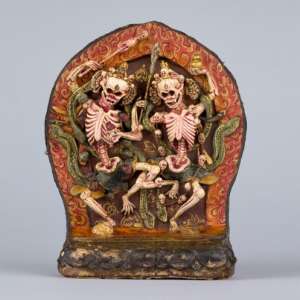
Learn more about Death Is Not the End in a guided audio tour.
Explore the notions of death and afterlife through the art of Tibetan Buddhism and Christianity with the exhibition’s curator.
Stop 601: Introduction
Why Death Is Not the End? Curator Elena Pakhoutova introduces the exhibition, which invites visitors to contemplate the universal human condition of impermanence and the desire to continue to exist.
Stop 602: Wheel of Life
This painting represents Buddhist beliefs about the cycle of life, death, and rebirth. Three mental poisons at its hub—attachment (rooster), anger (snake), and ignorance (pig)—propel beings to be born in a perpetual cycle of rebirth in the six realms of existence.
Stop 603: The Inferno
A terrifying central figure of Satan viciously grasps and consumes the damned souls in this depiction of the tortures of hell. Some of the tortures demonstrate a perceived relationship of punishment to the sins one committed in life.
Stop 604: The Last Judgment
Christ in heaven is surrounded by saints and the saved, who are shown ascending to heaven, while the damned are falling down and are on the ground. This print is among the earliest engravings of the Last Judgment fresco on the altar wall of the Sistine Chapel.
Stop 605: The Descent of Christ Into Limbo
Christ, in a sphere of radiance, guides the souls of those who died before there was the possibility of salvation through Jesus Christ. Fantastical beings, animals, and hybrid figures are torturing the souls of those who will not be saved.
Stop 606: Resurrection of Christ
This bronze relief is a second casting after the original that remains in the Church of the Holy Sepulchre in Jerusalem. Designed on a small scale and intended to be seen up close in a personal devotional context, this is the final image of six reliefs depicting the Passion (suffering) of Christ.
Stop 607: Life Story of Nangsa Wobum
This thangka painting depicts the story of Nangsa, who comes back to life after death and describes seeing beings suffering in hell due to their actions. Her story affects the lives of people around her who change their ways of behavior to avoid unfortunate rebirths.
Stop 608: Conquering Death: Transformation
Buddhist practitioners who engage in the practice of “cutting the ego” (chod) use implements during their meditation and rituals. Traditionally, they would engage in this practice at charnel grounds, places where dead bodies decompose or are eaten by vultures, to facilitate their experiences.
Stop 609: Parliament of Heaven
This miniature from the Book of Hours presents a sequence of events for contemplation in one’s prayer. Exhibition curator Elena Pakhoutova speaks with Roger Wieck, Melvin R. Seiden Curator and Department of Head at the Morgan Library & Museum about the depiction of heaven in this manuscript.
Stop 610: Four-Armed Avalokiteshvara in His Pure Realm
This painting depicts the mountainous island Potala—the realm of Avalokiteshvara, the deity of compassion—where devotees wish to be reborn. The exceptional composition and iconography of this painting visually and literally interpret Buddhist texts about this realm.
Death Is Not the End is supported by the E. Rhodes and Leona B. Carpenter Foundation, Ellen Bayard Weedon Foundation, Robert Lehman Foundation, and The Prospect Hill Foundation.
The Rubin Museum’s programs are made possible by the New York State Council on the Arts with the support of the Office of Governor Kathy Hochcul and the New York State Legislature.
This project is supported in part by the National Endowment for the Arts.





